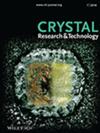铜锌锡硒化硫薄膜材料的光电性能研究:一种有前途的下一代太阳能技术薄膜材料
IF 1.9
4区 材料科学
Q3 CRYSTALLOGRAPHY
引用次数: 0
摘要
铜锌锡硫硒化(CZTSSe)薄膜材料是一种资源丰富、价格低廉、柔韧性强、对下一代光电技术具有重要意义的材料,其研究及其作为基础材料的应用正在得到广泛的研究。因此,本研究探索并报道了CZTSSe薄膜的合成及其关键光电特性。所报道的薄膜是通过物理气相沉积技术在钠石灰玻璃衬底上制备的,然后从250°C退火到450°C。从X射线衍射分析中发现,沉积薄膜的结构是无定形的。退火后的CZTSSe薄膜呈多晶性质,平均晶粒尺寸为46.3 nm,呈四边形结构。为了确定带隙能量,以及光学性质,使用了可见分光光度计和四探针技术。在450°C时,退火膜的带隙能量为1.64 eV,处于作为太阳能电池器件吸收层的最佳范围。同样,通过采用四探针技术,沉积薄膜的I-V特性表明,材料表现出非欧姆行为,而退火薄膜则表现出部分欧姆行为,电阻为670欧姆。本文章由计算机程序翻译,如有差异,请以英文原文为准。
A Study on Optoelectronic Properties of Copper Zinc Tin Sulfur Selenide: A Promising Thin‐Film Material for Next Generation Solar Technology
Studies on copper zinc tin sulpher selenide (CZTSSe) thin‐film material and its applications as a base material are intensively being researched since it is an earth‐abundant, inexpensive, flexible, and interesting material for next‐generation optoelectronic technologies. Apropos, this study explores and reports the synthesis of CZTSSe thin films and their key optoelectronics characteristics. The reported films are fabricated on a soda‐lime glass substrate by using a physical vapor deposition technique, and then annealed from 250 to 450 °C. From the X‐ray diffraction analysis, the structure of the as‐deposited thin films is found to be amorphous in nature. Annealed thin films of CZTSSe exhibit polycrystalline nature with an average crystallite size of 46.3 nm in tetragonal structure. To determine the bandgap energy, as well as optical properties, the visible spectrophotometer, and four‐probe techniques, are used. From the measurements, the bandgap energy of the annealed film is found to be 1.64 eV at 450 °C which is in the optimal range as an absorber layer for solar cell devices. Similarly, by employing the four‐probe technique, I–V characteristics for the as‐deposited thin films, the material shows non‐ohmic behavior whereas the annealed film demonstrates partially ohmic with a resistance of 670 ohms.
求助全文
通过发布文献求助,成功后即可免费获取论文全文。
去求助
来源期刊
自引率
6.70%
发文量
121
审稿时长
1.9 months
期刊介绍:
The journal Crystal Research and Technology is a pure online Journal (since 2012).
Crystal Research and Technology is an international journal examining all aspects of research within experimental, industrial, and theoretical crystallography. The journal covers the relevant aspects of
-crystal growth techniques and phenomena (including bulk growth, thin films)
-modern crystalline materials (e.g. smart materials, nanocrystals, quasicrystals, liquid crystals)
-industrial crystallisation
-application of crystals in materials science, electronics, data storage, and optics
-experimental, simulation and theoretical studies of the structural properties of crystals
-crystallographic computing

 求助内容:
求助内容: 应助结果提醒方式:
应助结果提醒方式:


